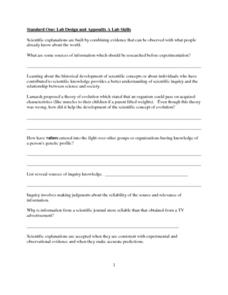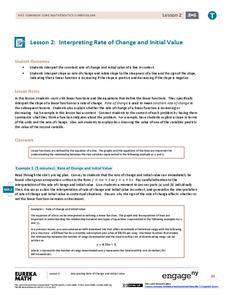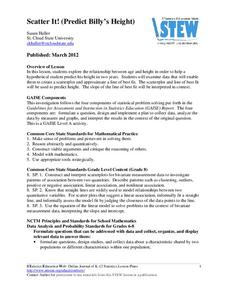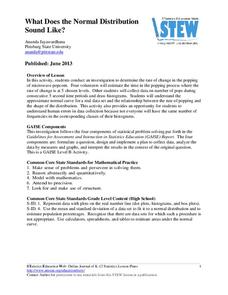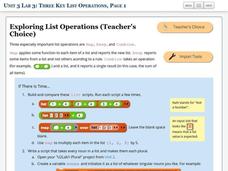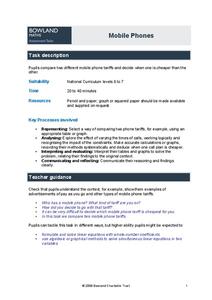Curated OER
Standard One: Lab Design and Appendix A Lab Skills
In this lab design and lab skills worksheet, young scholars answer questions about experimental design including finding variables, determining controls, and graphing data. They answer questions about microscopy and label the parts of a...
Curated OER
Backyard Critters
Young scholars explore the characteristics of invertebrates in their backyards. They observe, describe, and classify specimens. They conclude with a "snail race."
Curated OER
Arithmetic and Geometric Sequences
In this arithmetic and geometric sequences worksheet, 11th graders solve and complete 34 various types of problems. First, they find the described term in each sequence. Then, students complete the geometric sequences and find the value...
Curated OER
Arithmetic and Geometric Sequences
For this arithmetic and geometric sequences worksheet, 11th graders solve and complete 37 various types of problems. First, they determine the term of each sequence shown. Then, students find the given term number using sigma notation....
Curated OER
Functions and Fraction Combination
In this algebra worksheet, 11th graders factor polynomials and find the roots of the equations. They write the rules representing the equation and how to solve it. There are 9 questions.
Curated OER
Linear Equations
Students solve systems of linear equations by using inverse matrices lead by a class discussion. They write the identities of the matrices given, review, and grade as a class. Students also write the matrix as the product of the...
Mr. E. Science
Work and Machines
What would you be if you were attached to another object by an inclined plane wrapped helically around an axis? In this fourth presentation that covers work and simple machines, young physicists look at Newtons and Joules as...
EngageNY
Using Linear Models in a Data Context
Practice using linear models to answer a question of interest. The 12th installment of a 16-part module combines many of the skills from previous lessons. It has scholars draw scatter plots and trend lines, develop linear models, and...
Charleston School District
Graphs of Linear Functions
What does a slope of 2/3 mean? Develop an understanding of the key features of a linear function. Pupils graph the linear functions and explain the meaning of the slope and intercepts of the graphs.
Inside Mathematics
Population
Population density, it is not all that it is plotted to be. Pupils analyze a scatter plot of population versus area for some of the states in the US. The class members respond to eight questions about the graph, specific points and...
National Research Center for Career and Technical Education
Break-Even Point
How do companies determine the prices of their products? Marketing maestros discover the concepts of cost and break-even point through discussion, independent practice, and a collaborative assessment. The career and technology-oriented...
IB Psychology
Key Terms Traffic Lights
How much does your class know about psychology? What about empirical evidence? If they could use some time to learn the essentials of psychology, use a quick reference sheet to note what they know before the test, after the unit, and at...
EngageNY
Interpreting Rate of Change and Initial Value
Building on knowledge from the previous lesson, the second lesson in this unit teaches scholars to identify and interpret rate of change and initial value of a linear function in context. They investigate how slope expresses the...
American Statistical Association
Scatter It! (Predict Billy’s Height)
How do doctors predict a child's future height? Scholars use one case study to determine the height of a child two years into the future. They graph the given data, determine the line of best fit, and use that to estimate the height in...
Statistics Education Web
What Does the Normal Distribution Sound Like?
Groups collect data describing the number of times a bag of microwave popcorn pops at given intervals. Participants discover that the data fits a normal curve and answer questions based on the distribution of this data.
Statistics Education Web
Double Stuffed?
True or false — Double Stuf Oreos always contain twice as much cream as regular Oreos. Scholars first measure the masses of the filling in regular Oreos and Double Stuf Oreos to generate a class set of data. They use hypothesis testing...
Beauty and Joy of Computing
Three Key List Operations
Develop an understanding of the Map, Keep, and Combine operations. The lab leads the class through the exploration of three list operations. Each task contains a self-check to measure scholars' understanding of the operation in the...
Bowland
Mobile Phones
Cheaper cell phone bills? Learners compare two different cell phone plans for a specified number of minutes of phone usage each day. They also determine the conditions for which one plan is cheaper than the other.
American Statistical Association
How Random Is the iPod’s Shuffle?
Shuffle the resource into your lesson repertoire. Scholars use randomly-generated iPod Shuffle playlists to develop ideas about randomness. They use a new set of playlists to confirm their ideas, and then decide whether the iPod randomly...
Curated OER
One-Step Linear Equations
Sixth graders explore linear equations. In this linear equations instructional activity, 6th graders explore visual examples of 1-step linear equations. Students also practice solving problems that their instructors model.
Curated OER
Integers
For this integers worksheet, 9th graders solve and complete 14 different problems. First, they find a given number of consecutive integers with a given sum. Then, students determine the dimensions of a rectangle given the length and...
Curated OER
Example and Steps to Solving Linear Systems Using Substitution
In this linear equation worksheet, students solve five systems of linear equations using the substitution method. Three examples with steps to solve are provided.
Curated OER
Two-Step Equations
Sixth graders work through a two-step equation with their teacher. After reviewing one-step equations, they complete a worksheet using tiles and colored pencils to complete two-step equations. To end the activity, they write out the...
Curated OER
Addition/Subtraction Strategies
Third graders recall all their addition and subtraction facts to 20. They use the relevant number strategy with whole numbers. Students are taught place value in relation to decimals, and identify 'which decimal is larger.' They...


